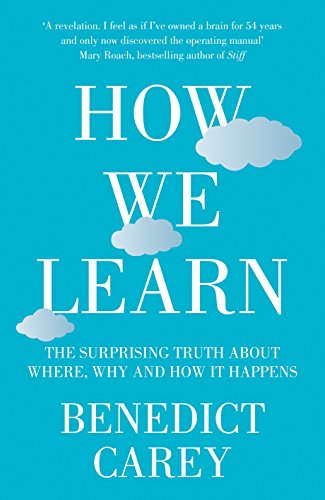Articles liés à How We Learn: The Surprising Truth about When, Where...

Synopsis
This book will help you to learn Spanish - or the Spanish guitar - faster. This book will give an athlete the edge to turn Silver into Gold. This book will give any child the chance to perform better in exams. Full stop. How We Learn is a landmark book that shakes up everything we thought we knew about how the brain absorbs and retains information. Filled with powerful - and often thrillingly counter-intuitive - wisdom, stories and practical tips, it gets to the very heart of the learning process; and gives us the keys to reach our very fullest potential in every walk of life. 'This book is a revelation. I feel as if I've owned a brain for 54 years and only now discovered the operating manual ...Benedict Carey serves up fascinating, surprising and valuable discoveries with clarity, wit, and heart.' Mary Roach, bestselling author of Stiff 'Whether you struggle to remember a client's name, aspire to learn a new language, or are a student battling to prepare for the next test, this book is a must. I know of no other source that pulls together so much of what we know about the science of memory, and couples it with practical, practicable advice.' Daniel T. Willingham, Professor of Psychology, University of Virginia 'Buy this book for yourself and for anyone who wants to learn faster and better.' Daniel Coyle, bestselling author of The Talent Code 'As fun to read as it is important, and as much about how to live as it is about how to learn. Benedict Carey's skills as a writer, plus his willingness to mine his own history as a student, give the book a wonderful narrative quality that makes it all the more accessible - and all the more effective as a tutorial.' Robert A. Bjork, Distinguished Professor of Psychology, University of California
Les informations fournies dans la section « Synopsis » peuvent faire référence à une autre édition de ce titre.
À propos de l?auteur
Benedict Carey has been an award-winning science reporter at the New York Times since 2004 and previously worked at the Los Angeles Times. His 2010 article on study habits was the most emailed New York Times piece ever in a single day. He is the author of How We Learn: Throw out the rule book and unlock your brain's potential.
Les informations fournies dans la section « A propos du livre » peuvent faire référence à une autre édition de ce titre.
EUR 4,04 expédition depuis Royaume-Uni vers France
Destinations, frais et délaisRésultats de recherche pour How We Learn: The Surprising Truth about When, Where...
How We Learn: The Surprising Truth About When, Where and Why it Happens
Vendeur : MusicMagpie, Stockport, Royaume-Uni
Etat : Very Good. 1754655572. 8/8/2025 12:19:32 PM. N° de réf. du vendeur U9780230767799
Quantité disponible : 1 disponible(s)
How We Learn: The Surprising Truth about When, Where and Why it Happens
Vendeur : WorldofBooks, Goring-By-Sea, WS, Royaume-Uni
Paperback. Etat : Very Good. The book has been read, but is in excellent condition. Pages are intact and not marred by notes or highlighting. The spine remains undamaged. N° de réf. du vendeur GOR006282583
Quantité disponible : 1 disponible(s)
How We Learn: The Surprising Truth about When, Where and Why it Happens
Vendeur : Orbiting Books, Hereford, Royaume-Uni
paperback. Etat : Very Good. marked cover and page edges, minor bumping Appears unread, may have minor damage from transit/storage. Next day dispatch from the UK (Mon-Fri). Please contact us with any queries. N° de réf. du vendeur mon0000681417
Quantité disponible : 3 disponible(s)
How We Learn: The Surprising Truth about When, Where and Why it Happens
Vendeur : Y-Not-Books, Hereford, Royaume-Uni
paperback. Etat : Very Good. Bumped edges. Marks to the edges of the pages. Next day dispatch. International delivery available. 1000's of satisfied customers! Please contact us with any enquiries. N° de réf. du vendeur mon0000340514
Quantité disponible : 1 disponible(s)
How We Learn: The Surprising Truth about When, Where and Why it Happens
Vendeur : Bestsellersuk, Hereford, Royaume-Uni
paperback. Etat : Very Good. Bumped edges and book is warped No.1 BESTSELLERS - great prices, friendly customer service â" all orders are dispatched next working day. N° de réf. du vendeur mon0000834674
Quantité disponible : 3 disponible(s)
How We Learn: The Surprising Truth About When, Where and Why it Happens
Vendeur : Mispah books, Redhill, SURRE, Royaume-Uni
Paperback. Etat : Like New. Like New. book. N° de réf. du vendeur ERICA75802307677965
Quantité disponible : 1 disponible(s)

